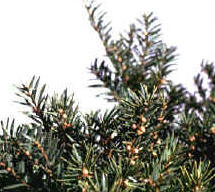 The yews are evergreen shrubs or small trees with reddish-brown bark in thin flaking scales; leaves are dark green to yellow-green, shaped like a narrow sickle, stiff, 1.25 to 2.5 cm long, and pointed at the apex. Flowers are axillary, small, inconspicuous, and unisexual. Fruit is bright scarlet red or sometimes yellow and fleshy. The yews are evergreen shrubs or small trees with reddish-brown bark in thin flaking scales; leaves are dark green to yellow-green, shaped like a narrow sickle, stiff, 1.25 to 2.5 cm long, and pointed at the apex. Flowers are axillary, small, inconspicuous, and unisexual. Fruit is bright scarlet red or sometimes yellow and fleshy.
Yews grow throughout North America but are widely used as ornamentals. Trimmings from the plants frequently cause poisoning in cattle, horses, and sheep. Taxine appears to be the toxic alkaloid. Where and When It Grows
Ground hemlock (Taxus canadensis) grows from midwestern to northeastern states and Canada, and is native to North America. It is found among coniferous woods and deciduous forests, along slopes, in ravines and marshes, and along rocky cliffs. Japanese yew (T. cuspidata) and English yew (T. baccata) grow throughout North America and are widely used as ornamentals. 
How It Affects Livestock
All species of livestock, humans, and pets are susceptible. However, horses and cattle are most often poisoned with trimmings from hedges or shrubs. Monogastrics are more sensitive. Clinical signs generally occur rapidly but may be delayed for up to 2 days depending on how much was ingested. Green foliage is toxic to ruminants at about 0.5 percent of the animal's body weight and 0.1 percent in monogastrics such as horses. Signs and Lesions of Poisoning Distress Dyspnea; rapid breathing Trembling, incoordination, and collapse Diarrhea, GI distress, abdominal cramping; vomiting in some species Rapid death from cardiac failure Pulmonary congestion and edema Irritation of the GI tract Diagnosis is based on identification of plant parts in the stomach contents and
history of clinical signs and sudden death How to Reduce Losses
Remove animals from the source and avoid discarding trimmings where animals have access. There is no specific treatment but atropine and lidocaine have been used to treat depressant effects and cardiac arrhythmias. |


 The yews are evergreen shrubs or small trees with reddish-brown bark in thin flaking scales; leaves are dark green to yellow-green, shaped like a narrow sickle, stiff, 1.25 to 2.5 cm long, and pointed at the apex. Flowers are axillary, small, inconspicuous, and unisexual. Fruit is bright scarlet red or sometimes yellow and fleshy.
The yews are evergreen shrubs or small trees with reddish-brown bark in thin flaking scales; leaves are dark green to yellow-green, shaped like a narrow sickle, stiff, 1.25 to 2.5 cm long, and pointed at the apex. Flowers are axillary, small, inconspicuous, and unisexual. Fruit is bright scarlet red or sometimes yellow and fleshy.
